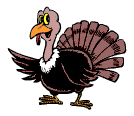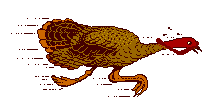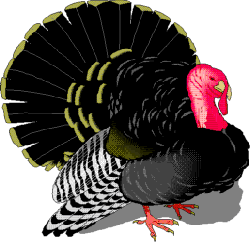

How did the TURKEY get its name? (here are a few ideas)
The wild turkey is native to Northern Mexico and the Eastern United States. Turkeys lived in North America almost ten million years ago . The turkey was domesticated in Mexico and brought to Europe in the 16th century. The American Indians hunted wild turkey for its meat as early as 1000 A.D. They made turkey "callers" out of turkey wing bones. The feathers were used to decorate ceremonial clothing. The spurs on the legs of wild tom turkeys were used on arrowheads and the feathers were used to stablize the arrows. Wild turkey became a source of food for the early settlers. The wild turkey nearly disappeared in the early 1900s because of overhunting and because trees were cut down to make way for farmland and communities. Ben Franklin thought the North American wild turkey should be the national bird (rather than the Bald Eagle) . In England, during the 1700s, turkeys were walked to market in herds. They wore booties to protect their feet. Turkeys were also walked to market in the United States. Turkeys are raised year round in Canada in specially designed barns. Canada ranks sixth out of ten for world turkey production. Most of the turkeys raised on turkey farms are White Hollands. They do not fly. (photo) Adult turkeys can have 3,500 feathers. Most turkey feathers are composted. Feathers are spread out on fields, then plowed under in the spring. The feathers decompose and fertilize the soil. Big Bird (from Sesame Street) is dressed in a costume of turkey feathers. His costume is made of nearly 4,000 white turkey feathers (dyed yellow). Wild turkeys spend the night in trees. They roost (perch) on the branches.  Wild turkeys can glide as far as a mile without flapping their wings. They can fly for short distances up to 88 km/hr (55 miles/hour). Wild turkeys can run 29 km/hr (18 miles/hour).  The turkey has an unusual looking bare head with a beak, caruncle, snood and wattle. (photo) Turkeys’ heads change colors when they become excited. The male turkey is called a tom or gobbler. The female turkey is called a hen. Baby turkeys are called poults. A turkey has 157 bones! According to the Guinness Book of Records the largest turkey raised was 39.09 kilograms (86 pounds) -- about the size of a large dog. 
How do you tell the HENS from the TOMS?
Male turkeys strut about, gobbling loudly and holding their heads high. They stick out their chests, fan their large tails and drag their wings on the ground. They do this to attract the attention of the female turkeys.

Gobbling turkeys can be heard a mile away on a quiet day. Turkeys don’t really have ears like ours, but they have very good hearing. A large group of turkeys is called a flock. Turkeys are related to pheasants and peacocks. As male turkeys gets older they fight a lot. They may even attack people. Turkeys can see movement almost a hundred yards away. Turkeys do not see well at night.
 More turkeys are eaten at Thanksgiving than for Christmas and Easter combined. The five most popular ways to serve leftover turkey -- as a sandwich, stew or soup, salad, casserole and stir-fry. Astronauts Neil Armstrong and Edwin Aldrin ate turkey in foil packets for their first meal on the moon.

Turkey eggs hatch in 28 days. A baby turkey is called a "poult". Turkey eggs are light tan with brown specks and are larger than chicken eggs. A turkey egg weighs from 80 grams to 100 grams (3 to 4 ounces). The average turkey hen will lay 110 to 115 eggs during a 28-30 week period.

A ballroom dance called the "turkey trot" was popular in the early 1900s.
The dance was named for the short, jerky steps that turkeys
take. Couples danced around in circles
bobbing their heads like strutting turkeys.
Turkey skins are tanned and used to make cowboy boots and belts.
|

QUIZZ - how well did you read?
about turkeys - photos, information, wild, domestic
a turkey label the parts